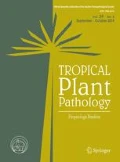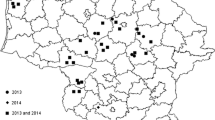Abstract
Members of Fusarium graminearum species complex are the main pathogens associated with Fusarium head blight (FHB) in wheat in Argentina, which produce trichothecene mycotoxins that are found in wheat grain and by-products. The aim of this study was to determine the chemotype and trichothecene genotypes of Fusarium graminearum species complex strains isolated from wheat in Argentina during an epidemic and a non-epidemic harvest season. A total of 115 and 108 strains obtained from wheat during 2012/13 and 2014/15 harvest seasons, respectively, were identified as belonging to the Fusarium graminearum species complex. PCR assays were used to differentiate the 15-acetyldeoxynivalenol (15-ADON), 3-acetyldeoxynivalenol (3-ADON) and nivalenol (NIV) genotypes. The trichothecene type B chemotype, zearalenone, and NX-2 toxin profiles were determined based on chromatographic (LC-MS/MS) analysis. Differences in the genotype frequency were due to the target locus analyzed and year of isolation of the strain. The most common genotype and chemotype was 15-ADON in both seasons, but an increasing frequency of the 3-ADON chemotype was found in the non-epidemic season (2014/15). The strains were able to produce zearalenone and its masked derivatives, but not the type A trichothecene NX-2. This is the first report of the production of zearalenone and its modified mycotoxins by Fusarium graminearum species complex strains isolated from Argentina.


Similar content being viewed by others
References
Alexander N, McCormick SP, Waalwijk C, Van der Lee T, Proctor R (2011) The genetic basis for 3-ADON and 15-ADON trichothecene chemotypes in Fusarium. Fungal Genet Biol 48:485–495
Alvarez CL, Azcarate MP, Pinto VF (2009) Toxigenic potential of Fusarium graminearum sensu stricto isolates from wheat in Argentina. Int J Food Microbiol 135:131–135
Astolfi P, dos Santos J, Schneider L, Gomes LB, Silva CN, Tessmann DJ, Del Ponte EM (2011) Molecular survey of trichothecene genotypes of Fusarium graminearum species complex from barley in southern Brazil. Int J Food Microbiol 148:197–201
BCR, Bolsa de Comercio de Rosario, Informes anuales (2015/16) Available at: https://www.bcr.com.ar/Pages/gea/estAnteriores.aspx.
Binder SB, Schwartz-Zimmermann HE, Varga E, Bichl G, Michlmayr H, Adam G, Berthiller F (2017) Metabolism of Zearalenone and its major modified forms in pigs. Toxins 9:56
Castañares E, Albuquerque DR, Dinolfo MI, Pinto VF, Patriarca A, Stenglein SA (2014) Trichothecene genotypes and production profiles of Fusarium graminearum isolates obtained from barley cultivated in Argentina. Int J Food Microbiol 179:57–63
Del Ponte EM, Spolti P, Ward TJ, Gomes LB, Nicolli CP, Kuhnem PR, Tessmann DJ (2015) Regional and field-specific factors affect the composition of Fusarium head blight pathogens in subtropical no-till wheat agroecosystem of Brazil. Phytopathology 105:246–254
Desjardins AE. (2006) Fusarium mycotoxins: chemistry, genetics, and biology. American Phytopathological Society (APS Press)
Desjardins AE, Proctor RH (2007) Molecular biology of Fusarium mycotoxins. Int J Food Microbiol 119:47–50
FAO, Food and Agriculture Organization of the United Nations (2015) Crop prospects and food situation N°4. Available at: http://www.fao.org/es/Giews/english/cpfs/index.htm
Gomes LB, Ward TJ, Badiale-Furlong E, Del Ponte EM (2015) Species composition, toxigenic potential and pathogenicity of Fusarium graminearum species complex isolates from southern Brazilian rice. Plant Pathol 64:980–987
Kelly A, Clear RM, O’Donnell K, McCormick S, Turkington TK, Tekauz A, Ward TJ (2015) Diversity of Fusarium head blight populations and trichothecene toxin types reveals regional differences in pathogen composition and temporal dynamics. Fungal Genet Biol 82:22–31
Kelly A, Proctor RH, Belzile F, Chulze SN, Clear RM, Cowger C, Ward TJ (2016) The geographic distribution and complex evolutionary history of the NX-2 trichothecene chemotype from Fusarium graminearum. Fungal Genet Biol 95:39–48
Kuhnem PR, Ward TJ, Silva CN, Spolti P, Ciliato ML, Tessmann DJ, Del Ponte EM (2016) Composition and toxigenic potential of the Fusarium graminearum species complex from maize ears, stalks and stubble in Brazil. Plant Pathol 65:1185–1191
Leslie JF, Summerell BA (2006) The Fusarium laboratory manual. Blasckwell Professional, Ames
Liang JM, Xayamongkhon H, Broz K, Dong Y, McCormick SP, Abramova S, Kistler HC (2014) Temporal dynamics and population genetic structure of Fusarium graminearum in the upper Midwestern United States. Fungal Genet Biol 73:83–92
Magliano TMA, Chulze SN (2013) Fusarium head blight in latin America. Springer, The Netherlands
Malachová A, Sulyok M, Beltrán E, Berthiller F, Krska R (2014) Optimization and validation of a quantitative liquid chromatography–tandem mass spectrometric method covering 295 bacterial and fungal metabolites including all regulated mycotoxins in four model food matrices. J Chromatogr A 1362:145–156
Malbrán I, Mourelos CA, Girotti JR, Balatti PA, Lori GA (2014) Toxigenic capacity and trichothecene production by Fusarium graminearum isolates from Argentina and their relationship with aggressiveness and fungal expansion in the wheat spike. Phytopathology 104:357–364
McCormick SP, Alexander NJ, Proctor RH (2013) Trichothecene triangle: toxins, genes, and plant disease. In phytochemicals, plant growth, and the environment. Springer, New York, pp 1–17
McMullen M, Bergstrom G, De Wolf E, Dill-Macky R, Hershman D, Shaner G, Van Sanford D (2012) A unified effort to fight an enemy of wheat and barley: Fusarium head blight. Plant Dis 96:1712–1728
Medina Á, Rodríguez A, Magan N (2015) Climate change and mycotoxigenic fungi: impacts on mycotoxin production. Curr Opin Food Sci 5:99–104
Moschini RC, Galich MTV, Annone JG, Polidoro O (2002) Fundamental-empirical approach to estimate Fusarium index in wheat. RIA J 31:39–53
Moschini RC, Martínez MI, Sepulcri MG (2013) Modeling and forecasting systems for Fusarium head blight and deoxynivalenol content in wheat in Argentina. In Fusarium Head Blight in Latin America, The Netherlands, Springer, p 205–227
Palazzini J, Fumero V, Yerkovich N, Barros G, Cuniberti M, Chulze SN (2015) Correlation between Fusarium graminearum and Deoxynivalenol during the 2012/13 wheat Fusarium head blight outbreak in Argentina. Cereal Res Comm 43:627-637
Pestka JJ (2010) Deoxynivalenol: mechanisms of action, human exposure, and toxicological relevance. Arch Toxicol 84:663–679
Reynoso MM, Ramirez ML, Torres AM, Chulze SN (2011) Trichothecene genotypes and chemotypes in Fusarium graminearum strains isolated from wheat in Argentina. Int J Food Microbiol 145:444–448
Sampietro DA, Marín P, Iglesias J, Presello DA, Vattuone MA, Catalan CAN, Gonzalez-Jaen MT (2010) A molecular based strategy for rapid diagnosis of toxigenic Fusarium species associated to cereal grains from Argentina. Fungal Biol 114:74–81
Sampietro DA, Díaz CG, Gonzalez V, Vattuone MA, Ploper LD, Catalan CA, Ward TJ (2011) Species diversity and toxigenic potential of Fusarium graminearum complex isolates from maize fields in northwest Argentina. Int J Food Microbiol 145:359–364
Sampietro DA, Ficoseco MEA, Jimenez CM, Vattuone MA, Catalán CA (2012) Trichothecene genotypes and chemotypes in Fusarium graminearum complex strains isolated from maize fields of northwest Argentina. Int J Food Microbiol 153:229–233
Schmidt-Heydt M, Parra R, Geisen R, Magan N (2011) Modelling the relationship between environmental factors, transcriptional genes and deoxynivalenol mycotoxin production by strains of two Fusarium species. J R Soc Interface 8:117–126
Scoz LB, Astolfi P, Reartes DS, Schmale IIIDG, Moraes MG, Del Ponte EM (2009) Trichothecene mycotoxin genotypes of Fusarium graminearum sensu stricto and Fusarium meridionale in wheat from southern Brazil. Plant Pathol 58:344–351
Umpiérrez-Failache M, Garmendia G, Pereyra S, Rodríguez-Haralambides A, Ward TJ, Vero S (2013) Regional differences in species composition and toxigenic potential among Fusarium head blight isolates from Uruguay indicate a risk of nivalenol contamination in new wheat production areas. Int J Food Microbiol 166:135–140
van der Lee T, Zhang H, van Diepeningen A, Waalwijk C (2015) Biogeography of Fusarium graminearum species complex and chemotypes: a review. Food Addit Contam Part A 32:453–460
Vary Z, Mullins E, Mselwain JC, Doohan F (2015) The severity of wheat disease increases whean plants and pathogens are aclimatised to elevated carbon dioxide. Glob Chang Biol 21:82–96
Vaughan M, Backhouse D, Ponte ED (2016) Climate change impacts on the ecology of Fusarium graminearum species complex and susceptibility of wheat to Fusarium head blight: a review. World Mycotoxin J 9(5):685–700
Vujanovic V, Goh YK, Daida P (2012) Heat-and cold-shock responses in Fusarium graminearum 3 acetyl-and 15 acetyl-deoxynivalenol chemotypes. J Microbiol 50:97–102
Ward TJ, Clear RM, Rooney AP, O’Donnell K, Gaba D, Patrick S (2008) An adaptive evolutionary shift in Fusarium head blight pathogen populations is driving the rapid spread of more toxigenic Fusarium graminearum in North America. Fungal Genet Biol 45:473–484
Wu F, Groopman JD, Pestka JJ (2014) Public health impacts of foodborne mycotoxins. Annu Rev Food Sci Technol 5:351–372
Acknowledgements
This study was supported by grant from ANPCyT PICT /12-1436. Nadia Yerkovich is a fellow from CONICET; Sofia Chulze and Juan Palazzini are members of the Research Career from CONICET.
Author information
Authors and Affiliations
Corresponding author
Additional information
Section Editor: Emerson M. Del Ponte
Rights and permissions
About this article
Cite this article
Yerkovich, N., Palazzini, J.M., Sulyok, M. et al. Trichothecene genotypes, chemotypes and zearalenone production by Fusarium graminearum species complex strains causing Fusarium head blight in Argentina during an epidemic and non-epidemic season. Trop. plant pathol. 42, 190–196 (2017). https://doi.org/10.1007/s40858-017-0155-3
Received:
Accepted:
Published:
Issue Date:
DOI: https://doi.org/10.1007/s40858-017-0155-3




